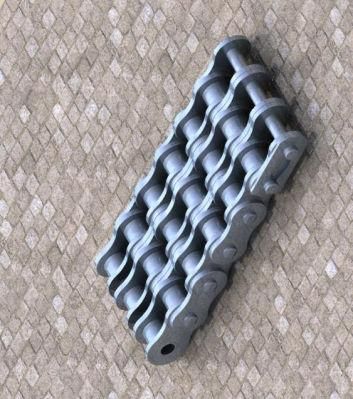
20bss-3 Engineering and Construction Machinery Triplex Stainless Steel Short Pitch Roller Chains and Bush Chain
Rizhao City Sanxing Chemicals Co., Ltd.- Standard or Nonstandard:Standard
- Application:Textile Machinery, Garment Machinery, Conveyer Equipment, Packaging Machinery, Electric Cars, Motorcycle, Food Machinery, Marine, Mining Equipment, Agricultural Machinery, Car, Food and Beverage Industry, Motorcycle Parts
- Surface Treatment:Polishing
- Structure:Rotransmission Chain, Pulling Chain, Driving Chain
- Material:Rubber
- Type:Transmission Chain, Pulling Chain, Driving Chain
Base Info
- Model NO.:20B
- Usage:Transmission Chain, Drag Chain, Conveyor Chain,
- Feature:Fire Resistant
- Color:Solid Color
- Function:Moisture and Acid Against
- Certificationtion:ISO90001, SGS
- Packaging:Industrial Packing or Customers′ Request
- Attachment:Can Be Customize
- Transport Package:Carton Cases. Pallet or Wooden Box
- Specification:Customer′s packaging requirements can be customize
- Trademark:OEM OR NO MARK
- Origin:China
- HS Code:7315119000
- Production Capacity:5000000meters,Year
Description
ASME/ANSI B29.1-2011 Roller Chain Standard Sizes
For mnemonic purposes, below is another presentation of key dimensions from the same standard, expressed in fractions of an inch (which was part of the thinking behind the choice of preferred numbers in the ANSI standard):
in eighths
chain number
1. The pitch is the distance between roller centers. The width is the distance between the link plates (i.e. slightly more than the roller width to allow for clearance).
2. The right-hand digit of the standard denotes 0 = normal chain, 1 = lightweight chain, 5 = rollerless bushing chain.
3. The left-hand digit denotes the number of eighths of an inch that make up the pitch.
4. An "H" following the standard number denotes heavyweight chain. A hyphenated number following the standard number denotes double-strand (2), triple-strand (3), and so on. Thus 60H-3 denotes number 60 heavyweight triple-strand chain.
A typical bicycle chain (for derailleur gears) uses narrow 1⁄2-inch-pitch chain. The width of the chain is variable, and does not affect the load capacity. The more sprockets at the rear wheel (historically 3-6, nowadays 7-12 sprockets), the narrower the chain. Chains are sold according to the number of speeds they are designed to work with, for example, "10 speed chain". Hub gear or single speed bicycles use 1/2" x 1/8" chains, where 1/8" refers to the maximum thickness of a sprocket that can be used with the chain.
Typically chains with parallel shaped links have an even number of links, with each narrow link followed by a broad one. Chains built up with a uniform type of link, narrow at one and broad at the other end, can be made with an odd number of links, which can be an advantage to adapt to a special chainwheel-distance; on the other side such a chain tends to be not so strong.
Roller chains made using ISO standard are sometimes called as isochains.
SEE ALSO
References
As much as 98% efficient under ideal conditions, according to Kidd, Matt D.; N. E. Loch; R. L. Reuben (1998). "Bicycle Chain Efficiency". The Engineering of Sport conference. Heriot-Watt University. Archived from the original on 6 February 2006. Retrieved 16 May 2006.
In the 16th century, Leonardo da Vinci made sketches of what appears to be the first steel chain. These chains were probably designed to transmit pulling, not wrapping, power because they consist only of plates and pins and have metal fittings. However, da Vinci's sketch does show a roller bearing.Tsubakimoto Chain Co., ed. (1997). The Complete Guide to Chain. Kogyo Chosaki Publishing Co., Ltd. p. 240. ISBN 0-9658932-0-0. p. 211. Retrieved 17 May 2006.
"What is MicPol?". Lubrication. Retrieved 3 October 2018.
Chains operating at high speeds comparable to those on motorcycles should be used in conjunction with an oil bath, according to: Lubrecht, A. and Dalmaz, G., (eds.) Transients Processes in Tribology, Proc 30th Leeds-Lyon Symposium on Tribology. 30th Leeds-Lyon Symposium on Tribology, 2-5 September 2003, Lyon. Tribology and Interface Engineering Series (43). Elsevier, Amsterdam, pp. 291-298.
Oil drip feed provided the greatest wear protection between chain roller and pin, Oil drip feed provided the greatest power saving over unlubricated chains and sprockets, according to Lee, P.M. and Priest, M. (2004) An innovation integrated approach to testing motorcycle drive chain lubricants. In: Lubrecht, A. and Dalmaz, G., (eds.) Transients Processes in Tribology, Proc 30th Leeds-Lyon Symposium on Tribology. 30th Leeds-Lyon Symposium on Tribology, 2-5 September 2003, Lyon. Tribology and Interface Engineering Series (43). Elsevier, Amsterdam, pp. 291-298.
"Riveted vs Cottered Chain - Panzit Library". starmachinechina.en.made-in-china.com. Archived from the original on 26 April 2012. Retrieved 17 January 2015.
ASME B29.1-2011 - Precision Power Transmission Roller Chains, Attachments, and Sprockets.
Tsubakimoto Chain Co., ed. (1997). "Transmission Chains". The Complete Guide to Chain. Kogyo Chosaki Publishing Co., Ltd. p. 240. ISBN 0-9658932-0-0. p. 86. Retrieved 30 January 2015.
Green 1996, pp. 2337-2361
"ANSI G7 Standard Roller Chain - Tsubaki Europe". Tsubaki Europe. Tsubakimoto Europe B.V. Retrieved 18 June 2009.
Bibliography
Oberg, Erik; Jones, Franklin D.; Horton, Holbrook L.; Ryffel, Henry H. (1996), Green, Robert E.; McCauley, Christopher J. (eds.), Machinery's Handbook (25th ed.), New York: Industrial Press, ISBN 978-0-8311-2575-2, OCLC 473691581.
External links
Wikimedia Commons has media related to Roller chains.
The Complete Guide to Chain
Categories: Chain drivesMechanical power transmissionMechanical power control
WHY CHOOSE US
1. Reliable Quality Assurance System
2. Cutting-Edge Computer-Controlled CNC Machines
3. Bespoke Solutions from Highly Experienced Specialists
4. Customization and OEM Available for Specific Application
5. Extensive Inventory of Spare Parts and Accessories
6. Well-Developed Worldwide Marketing Network
7. Efficient After-Sale Service System
